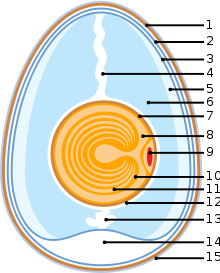Anatomy and Characteristics of Eggs
 |
Schematic of a chicken egg:
|
The shape of an egg resembles a prolate spheroid with one end larger than the other, with cylindrical symmetry along the long axis.
An egg is surrounded by a thin, hard shell. Inside, the egg yolk is suspended in the egg white by one or two spiral bands of tissue called the chalazae .
Air cell
The larger end of the egg contains the air cell that forms when the contents of the egg cool down and contract after it is laid. Chicken eggs are graded according to the size of this air cell, measured during candling. A very fresh egg has a small air cell and receives a grade of AA. As the size of the air cell increases, and the quality of the egg decreases, the grade moves from AA to A to B. This provides a way of testing the age of an egg: as the air cell increases in size, the egg becomes less dense and the larger end of the egg will rise to increasingly shallower depths when the egg is placed in a bowl of water. A very old egg will actually float in the water and should not be eaten.
Shell
Egg shell color is caused by pigment deposition during egg formation in the oviduct and can vary according to species and breed, from the more common white or brown to pink or speckled blue-green. In general, chicken breeds with white ear lobes lay white eggs, whereas chickens with red ear lobes lay brown eggs.[33] Although there is no significant link between shell color and nutritional value, there is often a cultural preference for one color over another.
White
White is the common name for the clear liquid (also called the albumen or the glair/glaire) contained within an egg. In chickens it is formed from the layers of secretions of the anterior section of the hen's oviduct during the passage of the egg. It forms around either fertilized or unfertilized yolks. The primary natural purpose of egg white is to protect the yolk and provide additional nutrition for the growth of the embryo.
Egg white consists primarily of about 90% water into which is dissolved 10% proteins (including albumins, mucoproteins, and globulins). Unlike the yolk, which is high in lipids (fats), egg white contains almost no fat, and the carbohydrate content is less than 1%. Egg white has many uses in food, and many others, including the preparation of vaccines such as those for influenza.
Yolk
The yolk in a newly laid egg is round and firm. As the yolk ages, it absorbs water from the albumen, which increases its size and causes it to stretch and weaken the vitelline membrane (the clear casing enclosing the yolk). The resulting effect is a flattened and enlarged yolk shape.
Yolk color is dependent on the diet of the hen; if the diet contains yellow/orange plant pigments known as xanthophylls, then they are deposited in the yolk, coloring it. Lutein is the most abundant pigment in egg yolk. A colorless diet can produce an almost colorless yolk. Yolk color is, for example, enhanced if the diet includes products such as yellow corn and marigold petals.[19] In the US, the use of artificial color additives is forbidden.
Egg yolk oil or egg oil is used for cosmetics and dermatology.